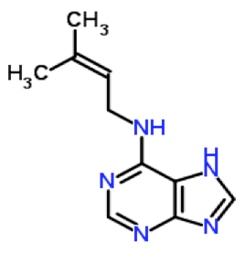
Isopentenyladenosine is abbreviated as i6A and is a modified nucleoside derived from mevalonic acid, which is a precursor in the biosynthetic pathway known as the mevalonate pathway that produces terpenes and steroids. The chemical molecular formula of Isopentenyladenine is C10H13N5.
Scientists at Creative Proteomics utilize a highly quantitative method with high-performance liquid chromatography (HPLC) for the determination of Isopentenyladenine levels in various samples, including Plant, Tissue and more. High-Performance Liquid Chromatography (HPLC) with UV detection is used for the determination of Isopentenyladenine (254 nm) levels in a lot of biological samples. This Methodology provides accurate, reliable, and reproducible results of Isopentenyladenine measurement, which enables us to analyze of Isopentenyladenine levels in vitro and in vivo.
Isopentenyladenine is an occurring cytokinin naturally, which can modulate the plant cell division and development as well as nutrient processing in plants. Isopentenyladenine also can be used as precursor to synthesize the zeatin and can promote the growth of lateral buds and stimulates cell division to produce bushier.Some studies indicate that isopentenyladenosine and its 4’-hydeoxylated analogue, zeatin, could substitute substitute for mevalonate in restoring DNA replication in compactin-blocked cells. Moreover, Isopentenyladenine can stimulate DNA synthesis during the S phase of the cell cycle like mevalonate. Isopentenyladenine also can reverse the inhibition of DNA synthesis which is caused by nalidixic acid. nalidixic acid is an antibiotic which does not inhibit cholesterol synthesis. Some research papers indicate that Isopentenyladenine and it’s closely related derivatives can regulate the activity of the mevalonate in DNA replication. These results also suggest that Isopentenyladenine may act upon DNA replication at a site common to that inhibited by nalidixic acid.
The Russian-Polish botanist M. Tswett is generally recognized as the first person to establish the principles of chromatography. In a paper he presented in 1906, Tswett described how he filled a glass tube with chalk powder (CaCO3) and, by allowing an ether solution of chlorophyll to flow through the chalk, separated the chlorophyll into layers of different colors. He called this technique “chromatography”. Fundamentally, chromatography is a technique used to separate the components contained in a sample. High Performance Liquid Chromatography (HPLC) is a method able to separate non-volatile, thermally unstable, and polar components separate or in a mixture. HPLC is a type of chromatography that, because of its wide application range and quantitative accuracy, is regarded as an indispensable analytical technique, particularly in the field of organic chemistry. It is also widely used as a preparation technique for the isolation and purification of target components contained in mixtures.
Isopentenyladenine Analysis Service at Creative Proteomics supports your research in Isopentenyladenine Analysis. HPLC Based Analysis Service Platform enable us at Creative Proteomics offers you a state-of-the-art Analysis Service.
Sample Type
Plant, Tissue and more
Method
High-Performance Liquid Chromatography (HPLC) with UV detection is used for the determination of Isopentenyladenine (254 nm) levels in a lot of biological samples. This Methodology provides accurate, reliable, and reproducible results of Isopentenyladenine measurement, which enables us to analyze of Isopentenyladenine levels in vitro and in vivo.
Send us your samples, you will get all information that you need!